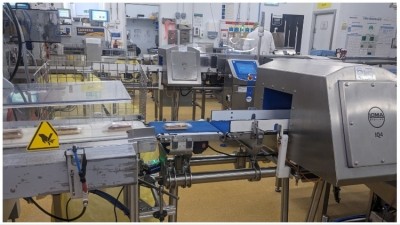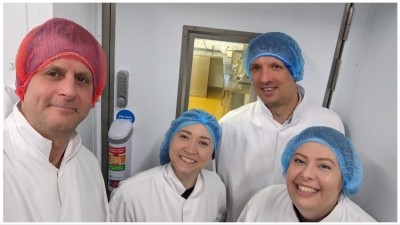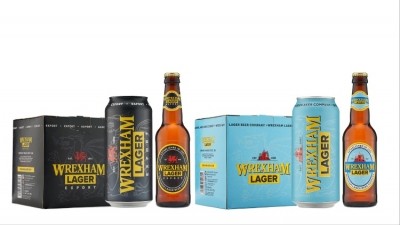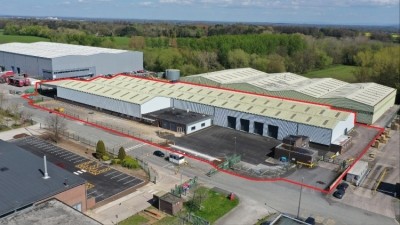Me & My Team
Baker & Baker and the gluten-free factory
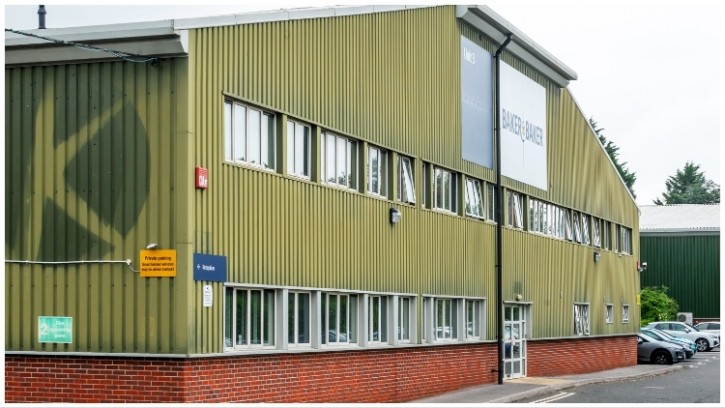
Company: Baker & Baker
Address: Wiston Business Park, London Road, Ashington, West Sussex, RH20 3DJ
Number of employees – Total site headcount including support functions and commercial: 177
Size of site – 3 units totalling 75,000 sqft
Shift patterns – 4x4, 12hr shifts covering 7 days a week
Output – Current output averaging over 30tns per week
Types of lines – Current capability includes: cake slices, flapjack, rocky road, brownies, millionaire shortbread, muffins, cupcakes, loaf cakes, round cakes, festive yule logs, festive fruit slabs, enrobed cake bars – and a variety of bespoke finishing and pack formats dependant on customer specifications.
Baker and Baker, which sold its CSM ingredients arm in 2021, is a European leader in bakery convenience, with approximately 2,500 employees across 12 sites and 7 countries.
Whilst headquartered in the Wirral, Merseyside, the business also boasts a small but capable, gluten-free factory in Ashington, Sussex, which has been part of the furniture since 1999.
It’s here I operate as the factory manager, overseeing the production of circa 4-5 tonnes a day– with plenty of ambition to grow.
I joined the team in 2018 and was part of the project to get the Ashington site more financially stable.
At the time, we were manufacturing both gluten-free and gluten-included products. Within units 2 and 3 of our facilities there was duplicate equipment, but we weren’t producing significant volumes in gluten-free.
The only way to grow the gluten-free part of the business was to relinquish the gluten-included segment to our sister sites. This was because, simply put, we didn’t have enough warehousing within the gluten-free unit to hold all the key components on site. So originally, they had to be housed in a shared warehouse – and that brings risk of contamination.
Now, Ashington is a gluten-free dedicated site. It has meant we have been able to reduce the risk of cross contamination and upskill our team as we’re more ‘focused’.
Managing cross contamination
Obviously with any free-from operating site, allergen training is imperative – and we have a dedicated training department at Ashington who run training continuously. But one of the key things we do is that every employee that works on site has to complete an allergy awareness course, so they understand their impact on the consumer.
Alongside this, we also have a European-wide procurement team in place that we source products through, and a supplier assurance programme to cross check with suppliers that everything is gluten free. In this way, we’re able to safely reduce testing on site, meaning we benefit from cost-savings without introducing risk. It also gives us the security to claim gluten-free because we know no gluten including ingredients have come on site in the first place.
The Swiss Army knife of the business
Of course, the challenge of gluten-free is that the market is a lot smaller; despite this, the range of gluten-free products we make is incredibly diverse. Compared to when I first started here, when the products were very much staples. Today, in terms of offering, quality and taste, we’re light years ahead of where we were. With so many capabilities in such a small arm of business, we’re a bit like the Swiss Army knife of Baker & Baker!
Since Baker & Baker struck out on its own, the business has been investing into the brand with new equipment and capabilities. At the Ashington site, the additions have been numerous, but one of my highlights is our chocolate enrobing line, introduced two years ago.
While our headquarters have similar capabilities, what makes the Ashington enrobing line unique is that we’re able to use it on smaller items. It sounds quite simple, but with gluten-free it rarely is! Chocolate is a very dynamic product, so when it comes to coating a cake, for example, a stable base product is needed. Gluten-containing sponges are generally quite robust, whereas a gluten-free sponge is less ‘sympathetic’, making the process of coating it with chocolate evenly a rather difficult feat.
We spent a lot of time developing that – and we’ve got new product lines we’re aiming to use that enrobing technology on in the future too.
Checking-in with the team
When it comes to running the site as plant manager, I like to be here by 6:30am. I’ve worked in the food industry for 32 years and because of that, I’ve done every shift pattern available, so it’s made me an early riser – and I like to be proactive.
Also, as this is a 24-hour site, with our night shift operating between 7pm-7am, being here earlier means I’m available for the night workers.
I generally start the day walking through the factory and checking in on as many people as possible. I see my role as a communicator, so one of the things I’ve tried to do is learn as many people’s names as possible. It’s a small thing, but it really helps to build that community spirit.
The morale here is great and that atmosphere is an important part of why people stay – in fact, 75% of the business has worked here for 5 years or more.
I think the shift pattern is also regarded favourably, it’s 12 hours, four days on, four days off. So it gives quite a lot of work-life flexibility to the team.
A lot of our recruitment is actually done through referring a friend, which I think has helped to create a positive working atmosphere as well. And we offer an incentive for recommendations.
We also have rewards for service, offering payment for 2, 5 and 10 years – and we pop people’s pictures on the wall to highlight these achievements.
Rewards are also given for good ideas, so if any of the staff on the shop floor can offer an idea that could increase efficiency or morale for example, if we implement it, we reward it.
One of the ideas that was recently awarded was around how we approach metal detection. For this we use a variety of different sized metal detection test sticks – and that information was previously kept on various documents which weren’t near to the live, at-hand document that the team used all the time for other tasks. One member of the team suggested we consolidate that and simplify the paperwork, so it was accessible in one place.
Little things like that make huge differences.
Overall, my goal as a leader is to promote people from within and give them a career. That’s what I got for myself and that’s what I want for others. I want this to be a place you can build a career, not just a place you come to do a job. We also class ourselves as a gluten-free centre of excellence and I want to continue growing that knowledge base by retaining the talented team we have.
The gluten-free market
As I mentioned before, the disadvantage is that gluten-free is a small market, but it is growing quite stably.
There are often fashionable trends within bakery and the wider food industry, things such as vegan, which has seen several peaks and troughs over the years. But gluten-free has proved to be a very sustainable sector, with retailers in the UK now giving a clear space on the shelf for this category – and maintaining that.
What we also noticed and wanted to address when we started out was that, previously, consumers were being shortchanged by gluten-free options.
Our range has now diversified so much, and we have also started to move into subsections of free-from, so free-from egg and/or milk in addition to gluten. This does entail quite a dramatic allergen cleaning process every six weeks, but there is a desire from retailers to build on the free-from offering in several ways.
Bonus interview: A fireside chat with Baker & Baker’s sustainability lead
Nicholas Bevan is Baker & Baker’s director of corporate communications and sustainability, a role that was created when the ingredients arm, CSM, was sold in 2021.
What may sound like a strange paring – comms and sustainability – it’s down to Bevan’s rich career history in PR which saw him looking after a number of sustainability-focused accounts.
But Bevan also added that communication is a key part of the manufacturer’s sustainability strategy: “We won’t be able to achieve what we want to achieve without bringing all our colleagues and external partners on the journey with us.”
Reflecting on the last three years, Bevan explained that the creation of this new position coupled with the spilt from CSM presented him and the whole business with a daunting but exciting opportunity.
“It was basically like having a blank sheet of paper to work from.
“We have a very clear sustainability strategy in terms of where we want to move towards and I have a very clear plan in terms of what we need to deliver – both on a short term and long term basis.
“We have three key considerations when it comes to sustainability – our ambitions and initiatives as a business, a wealth of consumer requirements, and regulatory deliverables which vary market to market.
“We have a huge amount of work in the next two years to be able to comply with some incoming European legislation. Our strategy has to dovetail with all those areas.”
“The CSRD [Corporate Sustainability Reporting Directive] is one of our current main focuses because we’ll need to report on this in two years’ time.”
This is a new EU directive which requires larger companies (operating in or which have dealings with the EU) to share information on how they monitor a range of ESG-related issues and their impact on the planet.
There are 3 criteria, with businesses fulfilling 2 or more obliged to adhere to the new rules. These are outlined below, but it’s worth noting SMEs will be affected later down the line too.
- A net turnover of more than $40m
- Balance sheet assets more than $20m
- More than 250 employees
“There is a huge data and information requirement needed to deliver on this,” continued Bevan. “We are in the process of laying a lot of the groundwork for this – we’re trying to understand where we currently have data and where it sits within our business and within what platforms. Then, once we’ve done that, it’s about filling in the gaps. It’s a hugely complex piece of regulation.”
Whilst this is a big priority, Bevan added that a more ‘imminent consideration’ is the deforestation rules.
In the most basic sense, these affect a range of commodities, including cocoa and oil, with companies required to undertake due diligence on the value chain to ensure these products have not been party to deforestation.
“There’s regulation being brought in at an EU level, with the potential for slight divergence between companies’ deforestation obligations as UK regulations are agreed,” Bevan commented. “As with our decarbonisation journey, we have to work with our suppliers on this. There’s a huge amount of work here for everyone – including that suppliers can comply and guarantee 100% deforestation-free throughout the supply chain.”
To help aid on its sustainability journey and to adhere to regulations old and new, Baker & Baker is undergoing a climate risk assessment.
“This will help us understand existing and future risks,” Bevan added.
“There are some raw materials we use which are at higher risk of deforestation and other climate-related issues, if you think about cocoa and oil. And we’re factoring in the findings into our long-term plan.”
Reflecting on the company’s progress, Bevan said he was proud but recognised there’s a long road ahead.
“There is much to do to understand how we are going to move towards net zero. We set our target at 2040, and we’ve also set an interim target at 2030 and which has been developed in line with climate science best practice, but that’s only six years away.
“But we are not alone – we’re all facing the same challenges.”
Indeed, the industry as a whole now needs to put its money where its mouth is, having set their net zero ambitions. Not all will achieve them; for those that do it’ll be down to some serious grafting, wise investments and comradery between partners and, most likely, competitors.
